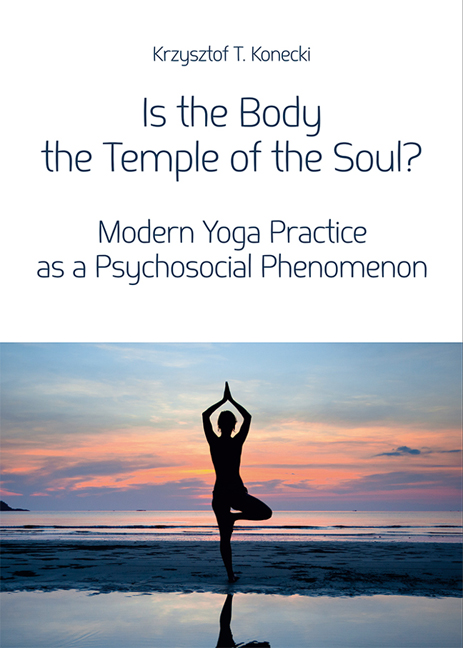Book contents
- Frontmatter
- Contents
- Foreword (Michał Szczepanik)
- Introduction
- Chapter 1 Philosophy and hatha-yoga practice. Para-religious aspects of hatha-yoga
- Chapter 2 The social world of yoga practice
- Chapter 3 Commonsense definitions of yoga and its meaning for practitioners
- Chapter 4 The process of becoming a hatha-yoga practitioner
- Chapter 5 Visual transmission of knowledge and the meaning of corporality and gestures in the social world of yoga practice
- Chapter 6 Emotions and yoga practicing. Working on emotions and achieving “emotional culture” without emotions
- Chapter 7 Teacher and guru in hatha-yoga practice
- Conclusions
- Bibliography
Chapter 6 - Emotions and yoga practicing. Working on emotions and achieving “emotional culture” without emotions
Published online by Cambridge University Press: 10 January 2018
- Frontmatter
- Contents
- Foreword (Michał Szczepanik)
- Introduction
- Chapter 1 Philosophy and hatha-yoga practice. Para-religious aspects of hatha-yoga
- Chapter 2 The social world of yoga practice
- Chapter 3 Commonsense definitions of yoga and its meaning for practitioners
- Chapter 4 The process of becoming a hatha-yoga practitioner
- Chapter 5 Visual transmission of knowledge and the meaning of corporality and gestures in the social world of yoga practice
- Chapter 6 Emotions and yoga practicing. Working on emotions and achieving “emotional culture” without emotions
- Chapter 7 Teacher and guru in hatha-yoga practice
- Conclusions
- Bibliography
Summary
Introduction
Yoga in the modern version, directed mainly to the Western receiver, for example, in the shape of so-called hatha-yoga, is directed to achieve therapeutic effects. Its modern propagators adjusted it to the needs of the man feeling strong civilizational stress caused by the pressure to venture so-called career dangers connected with nutrition, environment pollution, noise, pressure on consumption, and also with the institutional secularization of the modern society, etc. Thanks to it, in yoga schools, “work on emotions” that is done by specific physical practices (with the usage of the body) in order to gain emotional stability, elimination of negative emotions, and obtaining mental peace can take place. The work on emotions seems to be an internalized ritual of “modern religion” that most often is not seen for a side viewer and even for working on emotions. Work on the mental and physical health is a “boundary place” where the aspirations of the profanum sphere (practical goals of the individual) meet with the aspirations of the sacrum sphere (spiritual goals) of a given individual whose aims are the need to overcome own possibilities and existential fitness to become somebody else, so the old body would die and the new is born with a freshened psyche and in general without emotions. The work on emotions in hatha-yoga has thus an initial character if there is a visible change in the individual confirmed by its new interpretations of own emotions and own feeling.
I would like to show in the chapter what work on emotions in the social world of yoga practice is. The second goal is an attempt to interpret this phenomena in the light of the processes undergoing in the modern Western societies.
That yoga helps to shape the emotional stability is written by hatha-yoga's guru B. K. S. Iyengar (2005b). According to Iyengar, with the use of work on the body, you can get rid of the stress. Iyengar's attitude to yoga has a therapeutic character; it concerns both the physical and psychic sphere.
- Type
- Chapter
- Information
- Is the Body the Temple of the Soul?Modern Yoga Practice as a Psychosocial Phenomenon, pp. 177 - 194Publisher: Jagiellonian University PressPrint publication year: 2016



